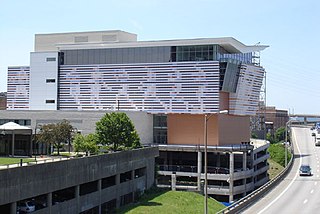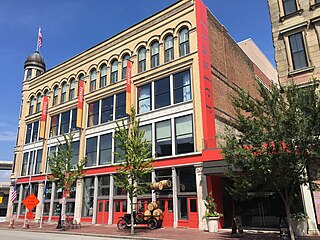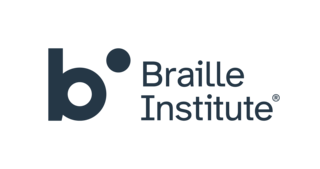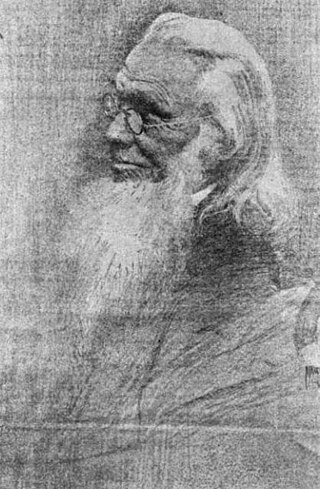
Braille is a tactile writing system used by people who are visually impaired. It can be read either on embossed paper or by using refreshable braille displays that connect to computers and smartphone devices. Braille can be written using a slate and stylus, a braille writer, an electronic braille notetaker or with the use of a computer connected to a braille embosser.

Louisville is the most populous city in the Commonwealth of Kentucky, sixth-most populous city in the Southeast, and the 27th-most-populous city in the United States. By land area, it is the country's 24th-largest city, although by population density, it is the 265th most dense city. Louisville is the historical county seat and, since 2003, the nominal seat of Jefferson County, on the Indiana border.

Braille music is a braille code that allows music to be notated using braille cells so music can be read by visually impaired musicians. The system was incepted by Louis Braille.

The history of books became an acknowledged academic discipline in the 1980s. Contributions to the field have come from textual scholarship, codicology, bibliography, philology, palaeography, art history, social history and cultural history. Its key purpose is to demonstrate that the book as an object, not just the text contained within it, is a conduit of interaction between readers and words. Analysis of each component part of the book reveals its purpose, where and how it was kept, who read it, ideological and religious beliefs of the period, and whether readers interacted with the text within. Even a lack of evidence of this nature leaves valuable clues about the nature of that particular book.

The Muhammad Ali Center is a non-profit museum and cultural center dedicated to boxer Muhammad Ali in Louisville, Kentucky. Ali, a native of Louisville, and his wife Lonnie Ali founded the museum in 2005.

The Louisville Slugger Museum & Factory, is a museum and factory tour attraction located in Louisville, Kentucky's "Museum Row", part of the West Main District of downtown. The museum showcases the story of Louisville Slugger baseball bats in baseball and in American history. The museum also creates temporary exhibits with more of a pop culture focus, including collaborations with the Norman Rockwell Museum, the Charles M. Schulz Museum and Research Center, Coca-Cola, LEGO artists Sean Kenney and Jason Burik, Topps Trading Cards, The Children's Museum of Indianapolis, and Ripley's Believe It or Not!.

The Frazier History Museum, previously known as the Frazier Historical Arms Museum and the Frazier International History Museum, is a Kentucky history museum located on Museum Row in the West Main District of downtown Louisville, Kentucky.
The American Foundation for the Blind (AFB) is an American non-profit organization for people with vision loss. AFB's objectives include conducting research to advance change, promoting knowledge and understanding, and shaping policies and practices.

The history of Louisville, Kentucky spans nearly two-and-a-half centuries since its founding in the late 18th century. The geology of the Ohio River, with but a single series of rapids midway in its length from the confluence of the Monongahela and Allegheny rivers to its union with the Mississippi, made it inevitable that a town would grow on the site. The town of Louisville, Kentucky was chartered there in 1780. From its early days on the frontier, it quickly grew to be a major trading and distribution center in the mid-19th century and an important industrial city in the early 20th. The city declined in the mid-20th century, but by the late 20th, it was revitalized as a culturally-focused mid-sized American city.

The National Federation of the Blind (NFB) is an organization of blind people in the United States. It is the oldest and largest organization led by blind people in the United States. Its national headquarters are in Baltimore, Maryland.
A braille translator is a software program that translates electronic text into braille and sends it to a braille peripheral, such as a braille embosser. Typically, each language needs its own braille translator. Despite the use of the word translator, there is no language translation. Even in the simplest situation, such as Dutch braille, has complex rules for capitalization, emphasis, punctuation, typographic symbols, and page formatting.

KMAC Contemporary Art Museum is an American art museum that "connects people to Art and Creative Practice". The museum is a 501c3 organization located in the West Main District of downtown Louisville, Kentucky.

The Bardstown Historical Museum is a museum of local history in Bardstown, Kentucky, USA, that is located in Spalding Hall, along with the Oscar Getz Museum of Whiskey History.

The American Printing House for the Blind (APH) is an American non-for-profit corporation in Louisville, Kentucky, promoting independent living for people who are blind and visually impaired. For over 150 years APH has created unique products and services to support all aspects of daily life without sight.
A sighted child who is reading at a basic level should be able to understand common words and answer simple questions about the information presented. They should also have enough fluency to get through the material in a timely manner. Over the course of a child's education, these foundations are built on to teach higher levels of math, science, and comprehension skills. Children who are blind not only have the education disadvantage of not being able to see: they also miss out on the very fundamental parts of early and advanced education if not provided with the necessary tools.

The Braille Institute of America (BIA) is a nonprofit organization with headquarters in Los Angeles providing programs, seminars and one-on-one instruction for the visually impaired community in Southern California. Funded almost entirely by private donations, all of the institute's services are provided completely free of charge. The organization has seven regional centers: Anaheim, Coachella Valley, Laguna Hills, Los Angeles, Riverside, San Diego and Santa Barbara, as well as outreach programs at more than 200 locations throughout Southern California. It is a member of the Braille Authority of North America.

A braille e-book is a refreshable braille display using electroactive polymers or heated wax rather than mechanical pins to raise braille dots on a display. Though not inherently expensive, due to the small scale of production they have not been shown to be economical.

James Morrison Heady was an American deafblind author. Heady published multiple volumes of children's books and poetry and was frequently referred to by the contemporary press as the "Blind Bard of Kentucky". He was one of the first advocates for books for the blind in the United States and he invented several devices to facilitate communication and improve quality of life for deaf and blind people.















